|
|
 |
Clark County Press, Neillsville, WI March 1, 1995, Page 32 Transcribed by Dolores (Mohr) Kenyon. Index of "Oldies" Articles
|
|
|
 |
Clark County Press, Neillsville, WI March 1, 1995, Page 32 Transcribed by Dolores (Mohr) Kenyon. Index of "Oldies" Articles
|
Good Old Days
By Dee Zimmerman
The last logging camp in Clark County was owned by Dells Lumber Company of Eau Claire. It was located west of the Christie bridge on Highway “H” and about one mile north of the Black River. Its last year of existence was in 1928, harvesting lumber in that area.
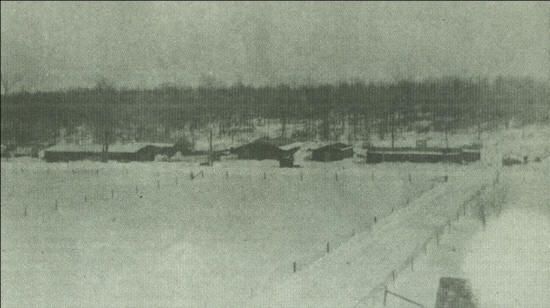 |
The last logging camp in Clark County was that of Dells Lumber Co. in 1928, located west of Christie along the Black River.
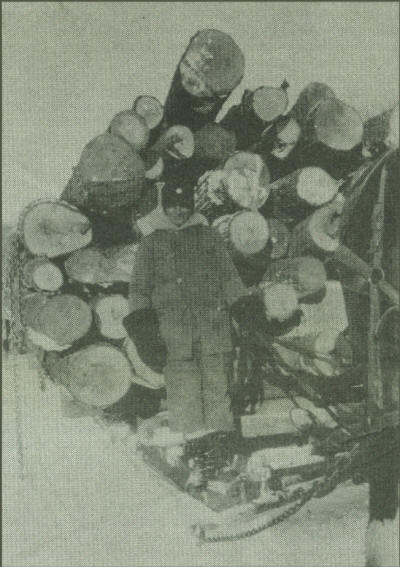 |
Ben Schwellenbach, age 18, worked at the Dells Camp during the winter of 1928. He worked as a teamster, hauling logs.
There were 125 men employed, working out of the camp, that year. The camp consisted of a large bunk house, cooking and dining shack, big horse barn that sheltered many teams, and storage shed.
The logging museum at an Eau Claire park is believed to have some of that equipment, preserved and on display.
Looking back through the archives on logging in the county during 1873-1874, reveals various events:
Oct. 31, 1873: “The annual ceremony of going into the woods has been observed by a few of the lumbermen, but the exodus for timber is very far from being as general as usual. The unusual scarcity of money and the depression in the lumber market are warning enough to most to let the pine stand, and keep out of debt. Considerable logging will, of course, be done by mill owners, and a few others may venture on a smaller scale for want of anything else to do, but beyond this there will be nothing done in the woods this winter.”
Dec. 1873: “The exit for the woods during this past week seemed to partake of its old time character, and hands were in active demand, though at reduced wages, averaging from $15 to $20 per month. Nearly all the old lumbermen here concluded to do something, which, with the very favorable season will increase until the aggregate amount of logging will amount to considerable after all.”
An article in regard to speculations on the pine lands was: “The limits of Wisconsin land district are – Town 15 to state line, Range 2 to 11 inclusive, the highest estimate of the number of acres of pine lands within the area mentioned, does not exceed 2,000,000 acres. The estimate includes many acres that are inaccessible as well as the entire portion that has already been cut over.
The Wausau district comprises at least one fourth the pine lands of the state; allowing then, that there are 2,000,000 acres within that district, and we have a total for the state of 8,000,000. Average pine yields, 5,000 feet to the acre; as a grand total then of stumpage of Wisconsin, we have 40,000,000,000 feet. The estimate includes as vast amount of timber that can never be utilized, and yet, even allowing that every foot is accessible, at present, rates of cutting – and the business increases the entire pineries of the state will be demolished within 50 years. Pine grows with wonderful rapidity, but it cannot keep pace with the destruction now going on. Pine lands must certainly increase rapidly in value, and within 10 years the fact that there has been an overstock of lumber on hand will seem merely whimsical.” A later article in 1873 ran this account on logging: “Throughout a large portion of Northern Wisconsin, there is a sufficiency of snow, the season has been favorable, except for the sloughs and lowlands that remain unfrozen, roads could be maintained with little extra labor of shoveling snow for handling logs. However the scarcity of money has had an affect on some loggers and their activity. It is questionable, due to circumstances, if the log crop of Michigan, Wisconsin and Minnesota will reach the proportions of cutting that was predicted earlier. The possibilities of an early break-up in spring could happen as early as March 1st. Then the loggers would be compelled to leave the woods, with logging coming to a halt. With the late start in the woods this season and early spring, logging estimates will prove to be wrong.
The spring trade is opening gradually, fairly prospective for the interest of manufacturers and dealers who have their stock in hand unencumbered. The winter’s work will close and seem trifling in comparison with that of the two preceding years but the results there from will be the establishment of former prosperity in the lumber business and interest of the land.”
The local logging story was a good report. That this has been one of the best logging seasons every known on Black River is generally agreed by all lumbermen, who are finding in it good compensation for the general depression in business which compelled them to go into the woods this winter with light forces.
Wm. J. Armstrong has a camp of eight men on Rock Creek, who put in on Jan. 31st, 800,000 feet of logs by actual scalement, or 100,000 feet to the man, which is generally counted as good winter’s work. He has now placed his figures for the winter, for this camp, at a million and a half.
Al Brown and several other lumbermen have already filled contracts that were supposed to occupy all the winter, and are now putting in logs for any good customer that may come along.
There will be nothing like the usual amount of logs put in this winter, but the indicators are that those who are engaged will make as much money even allowing for a dull market, as they have done any other season.”
Logging accidents were common as cutting down trees was a high risk job. February, 1874 recorded two fatalities in the same week, in Clark County. Lyman Moffat was struck by a fallen tree limb. At Chadwick’s Camp, on Popple River, Highland Thomas, foreman, was killed by a falling tree which fell the wrong way.
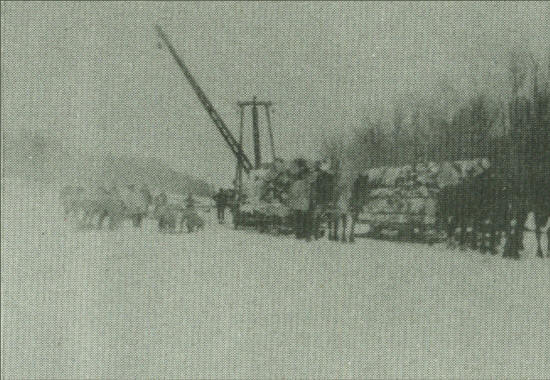 |
The log jammer in the process of loading logs on a bobsled
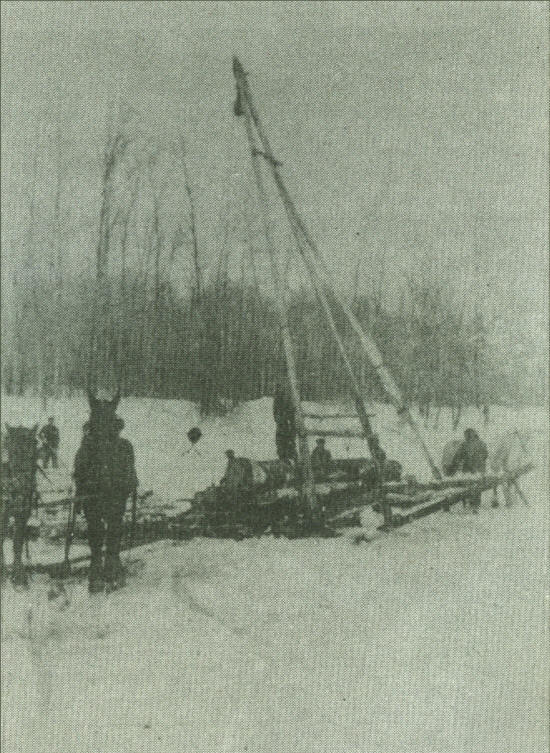 |
A log jammer used in moving logs. The pulley with its ropes was mounted on a crude put-together framework, made up of the right sized poles to make a jammer.
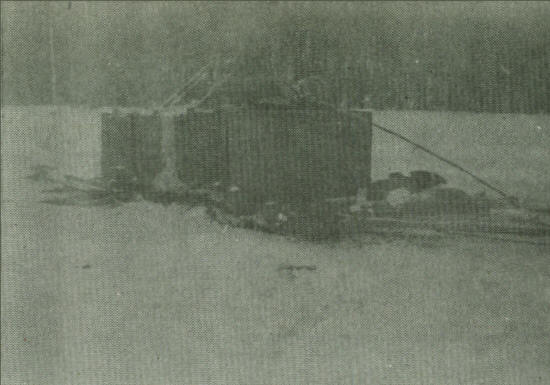 |
The wagon used to haul and pour water over the sled trails, making a coating of ice, enabling the loaded sleds to slide easier as logs were hauled out of the woods.
(Our thanks to Ben Schwellenbach for the photos, the life as a teamster couldn’t have been too bad; Ben will soon be celebrating his 85th birthday.)
The farther backward you can look the farther forward you are likely to see. – Winston Churchill
¤¤¤¤¤¤¤¤¤¤¤¤¤¤
Silence gives consent, or a horrible feeling that nobody’s listening. – Franklin P. Jones
¤¤¤¤¤¤¤¤¤¤¤¤¤¤
Increased means and increased leisure are the two civilizers of man. – Benjamin Disraeli
|
© Every submission is protected by the Digital Millennium Copyright Act of 1998.
Show your appreciation of this freely provided information by not copying it to any other site without our permission.
Become a Clark County History Buff
|
|
A site created and
maintained by the Clark County History Buffs
Webmasters: Leon Konieczny, Tanya Paschke, Janet & Stan Schwarze, James W. Sternitzky,
|